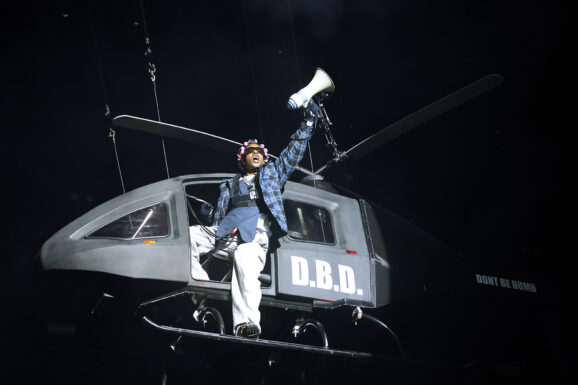Coy insinuation(s) of its title aside, Gov’t Mule’s sophomore studio effort built upon the first impression left by its 1995 self-titled debut. That is, on Dose (released 2/24/98), Warren Haynes, Allen Woody, and Matt Abts reinforced their intent to resuscitate the power trio concept in the wake of the prog-rock, punk, new wave, and grunge eras subsequent to the formative early work by Cream and the Jimi Hendrix Experience.
In the late Sixties, however, the blues influences of those seminal ensembles hadn’t yet been trampled upon by innumerable posers of questionable credibility. Still, by the time the guitarist and bassist–still working with the Allman Brothers Band in 1994–decided to unite with Matt Abts, the former drummer of Dickey Betts’ 1988 Pattern Disruptive group (of which both he and Haynes were members), blues and jazz-oriented rock such as the ABB’s had found favor with new audiences.
Hence the reunion of the Dixie rockers in 1989 that had proved stable and fruitful beyond its initial purpose (promotion of the splendid archival set Dreams out that same year). Add in the extra cache of widespread recognition of the Grateful Dead in 1987 via “Touch of Grey,” plus a burgeoning jam band ethos, and there was plenty of fertile ground for the Mule to explore.
And explore it they did..most vigorously. Virtually the entire song sequence of Dose has remained part of the Mule live repertoire in the quarter century since it was released and certain selections are still in regular rotation, including “Blind Man in the Dark,” “Thorazine Shuffle” and the cover of the Beatles “She Said She Said” (from 1966’s monumental Revolver album wherein also lies the source of teasing “Tomorrow Never Knows”).
Those first two numbers find the band hammering away as if in the midst of an extended improv. It hardly matters whether or not the main structure of such tunes or “Towering Fool” were actually lifted from the progressions from jams during before or after shows: the tunes accurately depict the three individuals’ respective styles of playing, thereby representing the open-ended attitude Gov’t Mule brought to their musical enterprise.
For a number like “Thelonious Beck”–a tribute to the recently-deceased British guitar hero– the twisting and turning of the electric guitar interweave with bass lines in perpetual motion. Meanwhile, drums accentuate the essential rhythm through suggestion: unlike so much of the output from so-called heavy bands that followed in the footsteps of the aforementioned iconic three-pieces, none of this plods.
On the contrary, Haynes, Woody & Abts display an ever-so-light touch during segments of “Game Face.” They exhibit a similar delicacy on “Raven Black Night,” too, with intricate acoustic work integrating strains of Indian music. The threesome’s shared grasp of dynamics meshes with Michael Barbiero’s production style too: engineering and mixing the recording, the latter maintains equal amounts of clarity and punch to do justice to the musicianship.
There’s a greater sense of liberation throughout Dose, than within its eponymous predecessor, but that’s only in relative terms. An almost claustrophobic sense of introspection arises from “Larger Than Life” (‘…everyone knows death is larger than life…’) and the psychic suffocation is even more pointed as it emanates from the avowal to ‘….return from my own hell…’ as declared in “I Shall Return” The double meaning in the title of the second Mule album hardly gives the lie to such inner conflict or the escape therefrom provided by the music.
In fact, it is fair to claim Dose is the studio corollary to the live album With A Little Help From Our Friends, released roughly a year later. Like the expansive concert package, the twenty-five-year-old LP is a definitive piece of work that can function equally well as an introduction to and summation of the varied strengths of this band.
Throughout the eleven cuts and sixty-five-plus minutes, the three-man Mule demonstrates a deep and abiding chemistry. It’s a bond eventually honed by assiduous practice and roadwork and one that, like the now-familiar (and ultimately malleable) logo emblazoning the front cover, becomes resplendent on this quarter-century-old album.








